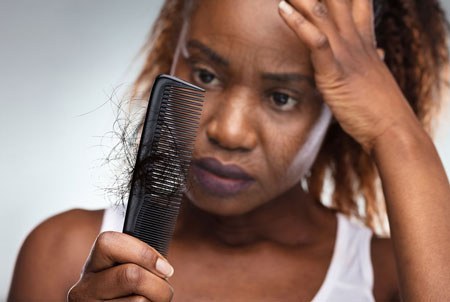Attention GCI Patients — Effective October 6, 2025, the GCI Oak Lawn location will be closed. All patients of GCI Oak Lawn will be seen at our Chicago Ridge location at 10604 Southwest Highway, Suite 109, Chicago Ridge, IL 60415.
There are several side effects that can be experienced as a result of cancer treatment— one of which is hair loss (alopecia). While this side effect is often feared by patients — especially women — it’s important to understand that not every cancer treatment will result in hair loss. Talking with your oncologist or cancer care team ahead of time will give you a better idea as to whether or not your specific treatment plan will cause you to lose your hair.
Common Questions Patients Ask About Hair Loss During Cancer Treatment
Do all chemotherapies (or cancer treatments) cause hair loss?
Some types of chemotherapy cause the hair on your head and other parts of your body to fall out. Radiation therapy could also result in the part of the body that is being treated to lose hair. On average, hair loss starts 2-4 weeks after the start of cancer treatment. You may experience thinning of the hair or complete hair loss. You should ask your Affiliated Oncologist cancer care team whether or not the treatment you are receiving might cause hair loss.

Why do cancer treatments cause hair loss?
Some cancer treatments harm healthy cells while also killing cancerous ones. Damage to the cells that help hair grow can affect different areas throughout the body including the head, face, arms, underarms, legs, and pubic area. Not all patients experience hair loss in the same way, even if they are undergoing the same kind of cancer treatment. For some, hair may slowly thin over time, but for others, it may come out more rapidly in clumps.
The good news is that hair loss is usually temporary, and will grow back after cancer treatment has been completed. It is not uncommon, however, for the color and texture of the hair to be slightly different when it first begins to grow back.
Coping with Hair Loss
Regardless of whether it’s partial or total, each person responds differently when learning that they may experience hair loss, and that’s okay. It’s often a big part of a woman’s identity and losing hair, even if just for a little while, can be hard to deal with.
Talking with your Affiliated Oncologist cancer care team regarding hair loss may help you plan ahead and cope better with this side effect. It may also help to talk about your feelings with family and friends or even a counselor.
Wearing a Wig
One way you can gain some control over the situation is by wearing a wig or a hairpiece. If you choose to do this, it’s a good idea to purchase your wig prior to beginning cancer treatment so it can be matched to your natural hair color, style, and texture. Once you begin to lose your hair, it often progresses quickly. This can make it more of a challenge for the wig stylist who may have only your description of your hair and/or pictures as a guide. If hair loss begins before your appointment with your wig stylist, save some pieces of your hair and take them with you. If possible, have your wig or hairpiece fitted properly at the shop to avoid scalp irritation. You may also consider buying two wigs, so that you will have one for everyday wear and another for special occasions.

Keep in mind that wigs made from human hair may cost more than a synthetic wig created with man-made fibers. This does not mean natural wigs are better. In fact, it can be hard to tell the difference between the two if the synthetic wig is made of high-quality material. Should you opt for a synthetic wig, consider having it professionally styled. Many wig salons offer this service, and the combined cost may be significantly less expensive than a custom wig.
For insurance purposes, be sure to ask your oncologist or nurse practitioner/physician assistant to write a prescription for a “hair prosthesis" or "cranial prosthesis” before purchasing a wig. While Medicare does not cover this under Part A or Part B, some insurance companies provide coverage for the purchase of wigs. Check with your insurance company regarding coverage and limits. Keep in mind that the costs of wigs, scarves, false eyelashes, etc. needed due to cancer treatments can also be tax-deductible medical expenses. Keep your receipts for these items.
Your Affiliated Oncologist cancer care team can direct you on where to find wig shops in the Chicagoland area. Or, you can shop online from places such as the American Cancer Society’s TLC.
Other Ways to Manage Hair Loss
For some patients, wearing hats, turbans, or scarves is a better alternative for them than wearing a wig. Some people even prefer to leave their heads uncovered.
Here are some other steps you can take to manage hair loss during cancer treatments:
Cutting your hair shorter before beginning treatment. A shorter hairstyle can make hair loss look less dramatic when it starts falling out. Some people choose to shave their head.
Treat your hair and scalp gently. Until your hair has fallen out, you may want to use a hairbrush with soft bristles or a wide-tooth comb. Do not use hair dryers, irons, straighteners or products such as gels or clips that may hurt your scalp or hair. Wash your hair with a mild, pH-balanced shampoo. Wash it less often and be very gentle when you do. Pat it dry with a soft towel or cotton t-shirt. When outdoors, protect your scalp with sunscreen, a hat, or a scarf. If your scalp feels itchy, treat it with a fragrance-free lotion. In colder weather, wear a hat or scarf to trap in body heat.
Taking medications. Certain medications may be helpful to treat thinning hair or for hair that did not fully grow back after cancer treatment. These prescription medications may include a topical medicine called minoxidil, or spironolactone (Aldactone), and finasteride (Propecia, Proscar), which are taken orally. Talk to your cancer care team to get a better idea of which medication is best for you and to get a prescription if needed.
Trying cold cap therapy. Cooling the scalp (scalp hypothermia) with ice packs or cooling caps (cold caps) before, during, and after chemotherapy treatments may reduce hair loss. The theory behind this is that the cooling tightens up or constricts blood vessels in the scalp, reducing the amount of chemo that reaches hair follicle cells. The cold also decreases the activity of the cells, making them less attractive to chemotherapy, which targets cells that rapidly divide.
Silk or satin pillowcase. Pillowcases made from softer fabrics such as these are gentler on a balding scalp and can decrease hair tangles.
When Will My Hair Grow Back After Cancer Treatment?
In many cases, hair begins to grow back within 2 to 6 months after the cancer treatment that caused it to fall out, has ended. As it comes in, keep in mind that it might not look the same as it did prior to treatment (curlier, straighter; different color or texture), however, it should eventually return to how it was before. If you received a very high dose of radiation, your hair may grow back thinner or not at all on the part of your body that received the cancer treatment.
Continue to be gentle with your hair as it grows back, caring for it as mentioned above. If you have any additional questions regarding hair loss, be sure to talk with your Affiliated Oncologists cancer care team.